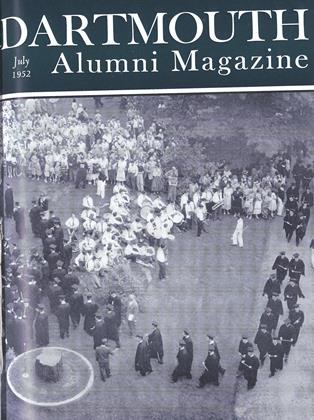by Prof. Carl L. Wilson, with linedrawings by Dr. Hannah T. Croasdale.Dryden Press, New York, N. Y. 1952. $6.10. Professor Wilson's new text is one in which he should feel great satisfaction, and it is my belief that many teachers of introductory courses in botany will find it a most satisfactory class text.
Since this review is not written for a professional publication, it seems quite unnecessary to give any detailed description of the scope or the arrangement of the contents. Suffice to state that it covers the field very adequately, yet the author has wisely avoided the mistake of such detailed coverage that the beginning student becomes confused by a welter of unessentials. The subject is presented in such a manner as to serve a double purpose: to be interesting to the student who elects botany as a part of his general education, yet also to serve as a thorough foundation for the student who plans a professional career in botany or any of its related fields of science.
The book is well written in a style which is easy for the student to comprehend, and the use of technical terminology is kept to a minimum consistent with an adequate training in the subject. Furthermore, the technical terms which have been used are properly emphasized in italics and so clearly defined as to render them easily understood by the reader. Understanding of such terms, and of the text in general, is further helped by profuse illustrations, both line drawings and photographs.
The photographic illustrations are well reproduced and the line drawings by Dr. Croasdale are the best that I have seen in any of the numerous botanical texts. They are beautifully executed and, in their clarity and simplicity, unusually helpful to an understanding of the text. Dr. Croasdale deserves high credit for her contribution. The publishers also are to be congratulated on the design and lay-out. The double column pages, together with the illustrations set off by red borders, and the line drawings printed in both red and black, add greatly to both the readability and the attractiveness of the book.
Naturally, as a text, the book is designed for use by the student, but it is also one in which the lay reader will find much interesting material.
 View Full Issue
View Full Issue
More From This Issue
-
 Article
ArticleThe Fifty-Year Address
July 1952 By E. BRADLEE WATSON '02 -
 Article
ArticleThe 1952 Commencement
July 1952 -
 Article
ArticleBaccalaureate Address
July 1952 By SIR OLIVER S. FRANKS -
 Article
ArticleDartmouth Awards Mine Honorary Degrees
July 1952 -
 Class Notes
Class NotesThe Big 25th for 1927
July 1952 By DOANE ARNOLD '27 -
 Class Notes
Class NotesA Glowing 190 7 Report
July 1952 By H. RICHARDSON LANE '07
James P. Poole
Books
-
 Books
BooksAlumni Publications
January 1945 -
 Books
BooksFaculty Notes
February 1947 -
 Books
BooksThe Land Was Theirs
September 1976 By Alexander G. Medlicott Jr. '50 -
 Books
BooksFAINTING.
JULY 1963 By HARRY T. FRENCH '13, M.D. -
 Books
BooksMINK AND RED HERRING,
October 1949 By Herbert F. West '22 -
 Books
BooksZOO OR LETTERS NOT ABOVE LOVE.
MAY 1972 By SAM DRIVER



